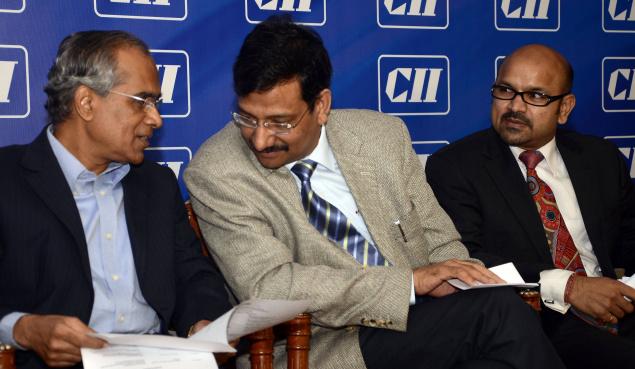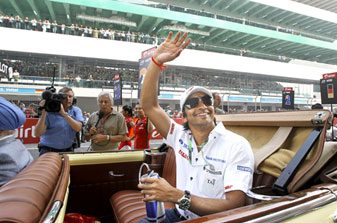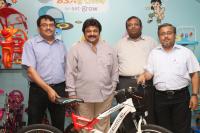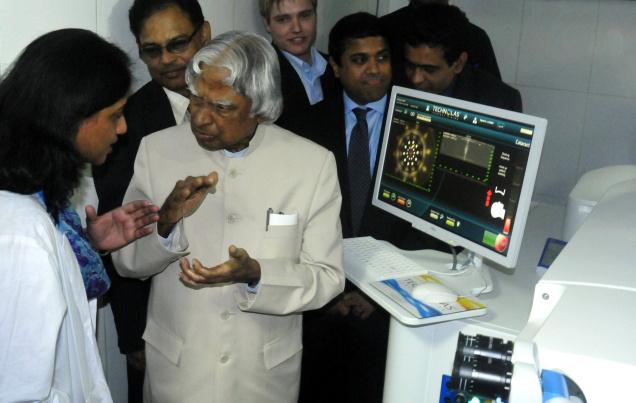Vivek Sharma, like many Indians who came to Singapore for work, failed to jump into the island state’s booming property market before the government imposed taxes to deter foreign buyers.
Now, he is joining thousands of his compatriots who are taking advantage of the drop in the rupee to a record low in December and seeking to buy property back home — for rental investments, homes for left-behind family members, retirement properties and residences for their own eventual returns.
“I missed the opportunity to buy property in Singapore when I moved here 2 1/2 years back,” said Sharma, 38, a medical-device manufacturing executive who was among 3,300 attendees at a two-day home fair in January where 53 Indian developers were showcasing their properties and discounting them to boost sales. “Now, prices have risen a lot, and with the new taxes, it makes better sense to invest back home.”
India’s property market may attract $3 billion from overseas buyers this year, almost double last year’s $1.6 billion, Shobhit Agarwal, joint managing director at the Indian unit of Jones Lang LaSalle Inc. (JLL), the world’s second-biggest, publicly traded commercial-property broker, said in an interview in Mumbai in December. About one-third typically comes from individuals like Sharma and two-thirds from investors, he said.
Housing Development Finance Corp. (HDFC), India’s largest mortgage lender and the organizer of the annual Singapore home fair, said the number of developers participating rose 26 percent over last year, while there were 27 percent more attendees. Among those taking part were DLF Ltd. (DLFU), Unitech Ltd. (UT) and Emaar MGF Land Ltd (EMGF). HDFC conducts similar fairs in Kuwait, Dubai — where the next is scheduled for April — and in London.
Sales Declines
The volume of property sales has declined in India’s biggest cities, including Mumbai, New Delhi, Hyderabad and Bangalore, after the nation’s central bank raised borrowing costs by a record 375 basis points since March 2010. The bank is seeking to curb inflation, although property prices remain at or close to record highs.
At the same time, the rupee fell 16 percent against the U.S. dollar in 2011, the worst performer among Asian currencies. The currency has since recouped some of its losses, climbing 7.7 percent to 49.45 to the U.S. dollar last month. It is forecast to fall to 52.25 in the quarter ending in March, according to the median estimate in a Bloomberg survey.
India’s record trade deficit may turn developing Asia’s best-performing currency in January into its biggest loser from now until the year-end, strategists forecast. The rupee will drop 1.2 percent in the rest of 2012, based on the median prediction of 22 analysts in a Bloomberg survey. That is the worst outlook among the region’s 10 most-traded currencies excluding the Japanese yen.
Agarwal at Jones Lang LaSalle said India’s property prices may decline 10 percent this year, and that with a potential 20 percent loss in the currency, property purchases will become even more attractive to overseas Indians.
“They get a net 30 percent discount, so they will be ready to write the check,” Agarwal said.
Cutting Prices
In Mumbai, where Sharma hopes to buy property as an investment and ultimately for retirement, residential home sales dropped 17 percent to a three-year low in the final quarter of last year compared with the previous quarter, according to Mumbai-based Liases Foras Real Estate Rating & Research Pvt. The dismal sales will spur developers to cut prices to boost volumes,Pankaj Kapoor, founder of Liases Foras, said.
In Singapore’s prime districts such as Orchard Road, a typical three-bedroom apartment would sell for about $2,000 a square foot, or around $4 million. A similar-sized apartment in Mumbai’s posh Malabar Hill would sell for about 25 percent less. Home prices in Singapore soared 55 percent from June 2009 through December 2011, while in Mumbai they nearly doubled in the same period.
Once-in-Lifetime
“Indians living abroad feel the rupee depreciation is a temporary phenomenon because the Indian economy is far stronger than most of the global economies,” J.C. Sharma, Managing director at Bangalore-based Sobha Developers Ltd. (SOBHA) said in an interview in Chennai. “They feel this as a once-in-lifetime kind of opportunity to convert their savings from dollars and other foreign currencies to an Indian asset which they think has a much better future in the times to come.”
India’s economy expanded 6.9 percent in the quarter that ended in September, the weakest pace since 2009. The government Central Statistical Office on Feb. 7 cut India’s growth forecast to 6.9 percent for the year ending in March from 7.6 percent predicted in October. Growth in Asia’s third-largest economy has slowed in the current financial year as Europe’s sovereign-debt crisis hampers global expansion.
Foreigners accounted for 31 percent of home buyers in Singapore before the government imposed an additional 10 percent stamp duty on them in December, according to government data. Before the new tax, the government levy on foreigners was 1 percent on the first S$180,000 ($139,000) of the purchase price, an additional 2 percent on the next S$180,000 and 3 percent on the remainder.
Reining in Prices
Sales of Singapore private homes dropped in December to 632 units, the lowest in two years. Singapore has been attempting to rein in prices since 2009, when the government barred interest- only loans for some housing projects and stopped allowing developers to absorb interest payments for apartments still being built.
“We have been far more aggressive in the Singapore market now as we have been getting a better response from this market,” said Surendra Hiranandani, founder of Mumbai-based House of Hiranandani, which showed its Chennai and Bangalore developments at the Singapore home fair.
“Over the past two years when markets in the West and Middle East crashed and hopes of a major revival seem bleak, interest in the Indian market has increased,” he said, adding that Singapore-based buyers have doubled to 10 percent of international purchasers from two years ago. “Other places like China and Australia are quite saturated as they are overbuilt, whereas India is still an undersupplied market. Definitely, the rupee is a stimulating factor.”
Higher Mortgage Rates
Even though property prices are lower in India, mortgage rates are 10 times higher at about 11 percent compared with between 1 percent and 2 percent in Singapore.
Mumbai-based Lodha Group offered its Singapore customers a chance to freeze the exchange rate at the home fair at 51.6 rupees to the dollar by hedging the currency on behalf of buyers.
For Manoj Mundra, a software professional employed with Cognizant Technology Solutions Corp. (CTSH) in Singapore, such offers and discounts from builders will aid his decision to purchase a property in India.
“It’s a good time to invest in India as you are getting more bang for your buck with the rupee depreciation,” Mundra, 41, said. Having lived in Singapore for six years, he is looking to purchase a home in Gurgaon, a suburb near New Delhi, the nation’s capital.
One-Tenth the Cost
A product of India’s seven years of surging economic growth, Gurgaon and its gated communities for the burgeoning middle class have swallowed up farmland. Homes in the area range from two-bedroom apartments starting at 5.3 million rupees to five- bedroom units for more than 50 million rupees, averaging around S$151 a square foot — about one-tenth the cost of a similar- sized apartment in the comparable Tampines area of Singapore.
Indians in Singapore make up 9 percent of the country’s resident population, forming the third-largest ethnic group after the Chinese and Malays, according to government data. Foreigners in Singapore account for 37 percent of the population.
Indians accounted for 3.7 percent of Singapore’s total home purchases last year, according to data from the Urban Redevelopment Authority. The top foreign buyers in the final quarter of 2011 were Chinese, followed by Indonesians, Malaysians and Indians, according Yang Liang Chua, head of research for Southeast Asia at Jones Lang LaSalle.
“The trend will be that a lot of the Indian wealth that is overseas will start finding its way back to India,” said Agarwal. “This is a new window that is opening.”
To contact the reporter on this story: Pooja Thakur in Singapore at pthakur@bloomberg.net
To contact the editor responsible for this story: Andreea Papuc at apapuc1@bloomberg.net
source: http://www.Bloomberg.com / News / by Pooja Thakur / February 09th, 2012




